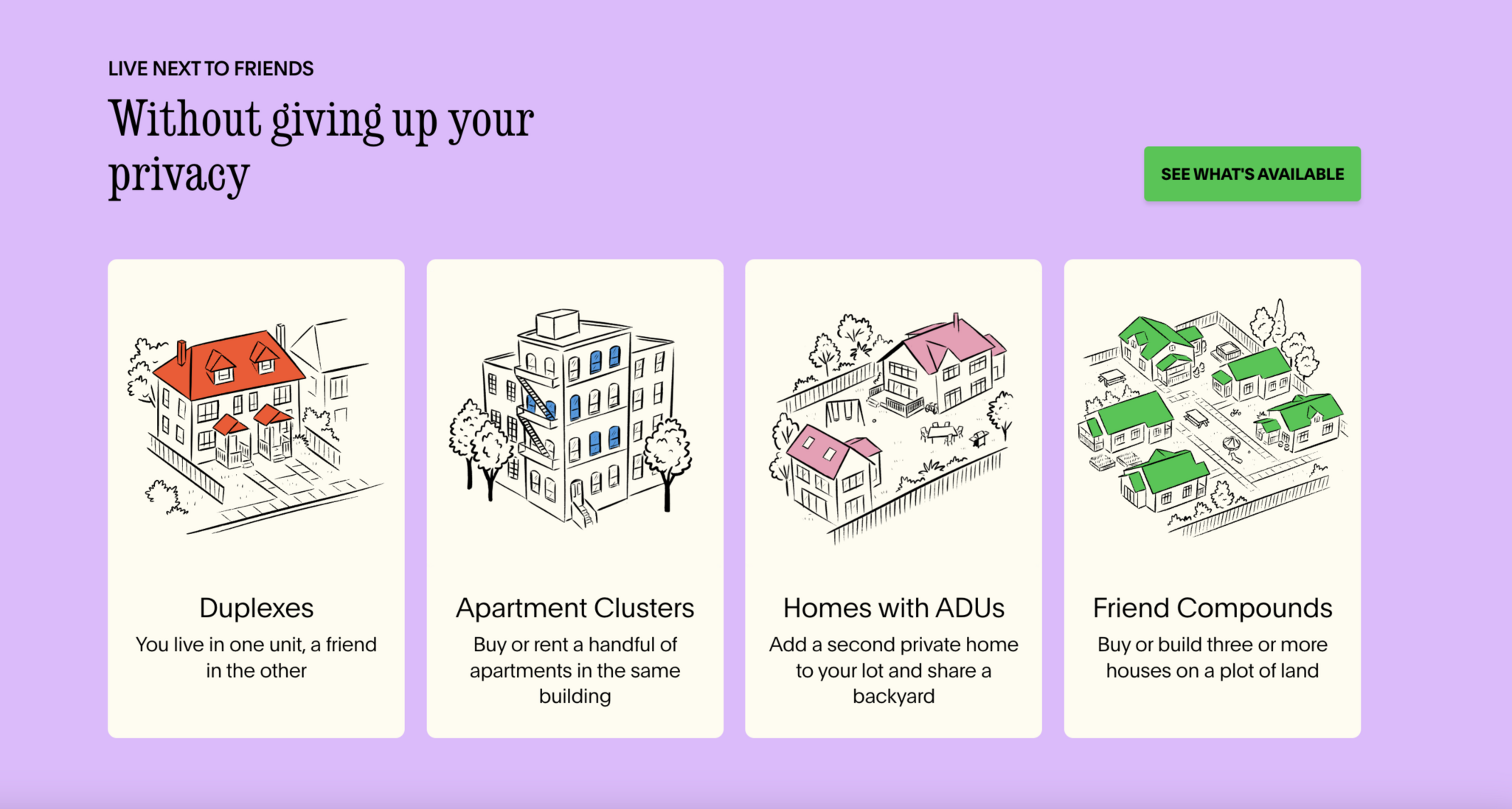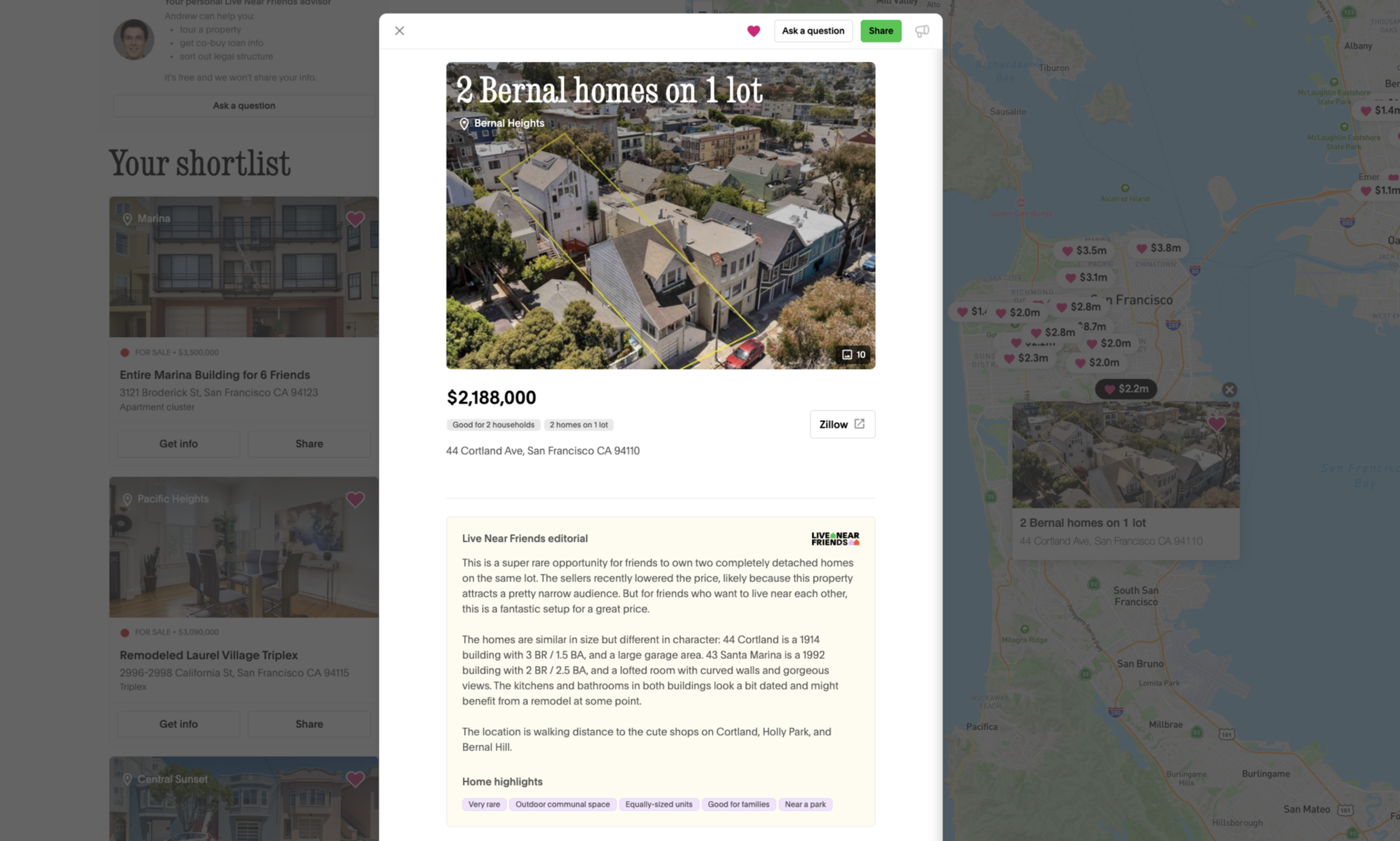For years, my college friends, dispersed across the U.S., have been locked in an iMessage chain about how to realize our dream of living closer to one another. We’ve mapped out our must-haves: affordable housing, access to good schools, walking distance to yoga, within earshot of nature. But coordinating careers, family commitments, and financing logistics was an organizational nightmare.
Predictably, the text chain fizzled out, only to reignite last month, when the U.S. surgeon general (opens in new tab) issued a warning about isolated parents losing their minds.
Then I got wind of a potential solution to our isolation nightmare: Hot Friend Compounds.

This attractively named concept was dreamed up by Phil Levin, a 40-year-old Oakland resident with serious house-buying chops. Levin’s résumé includes co-founding team member of Culdesac (opens in new tab), a startup that builds car-free neighborhoods in Arizona; penning Supernuclear (opens in new tab), a 7,000-subscriber Substack about co-living; and building out Radish (opens in new tab), an Oakland compound that, as of last year, he shares with 20 adults and 5 babies living in 10 homes in six buildings with a shared backyard.
“Co-buying is a fantasy for friends, but it’s really hard to pull off,” said Levin. Enter Hot Friend Compounds (opens in new tab), the first product of his new startup, Live Near Friends, which launched in 2023 with the goal of turning group-chat dreams into brick-and-mortar reality. Levin wants Hot Friend Compounds to be a one-stop shop for friend groups, hot or not, who are looking to buy homes together.
“Our bread and butter is people who are thinking about having kids, just had kids, or have kids and realize they need a different way to live,” he said.
A recent marketing email from Live Near Friends seemed to target another demographic: “We’ve heard you loud and clear. … You want that cluster of apartments all in the same building with your buds upstairs and down. … We will help you find your dream compound.”

There’s a real demand for what Levin is offering; 14% of millennials have purchased property with friends, according to a 2023 Zillow survey (opens in new tab), compared with 1% of baby boomers and 4% of Gen Xers. Meanwhile, 70% (opens in new tab) of Gen Zers are open to co-buying, according to one survey.
Affordability is one obvious reason; 44% of co-buyers are motivated by skyrocketing home prices. But socialization is also a key driver: 19% of co-buyers reported that proximity to friends is a priority.

“People have been doing this forever, but there’s more interest right now,” said Lisa Zahner, (opens in new tab) a Bay Area realtor who specializes in residential, multifamily, and investment properties. “It’s gaining more traction because people are looking at the market and thinking, how can I get in?”
The Hot Friend Compounds interface on Levin’s site makes this simple: Friends complete a brief questionnaire to drill down on priorities: a bigger yard versus more indoor hosting space, openness to fixer-uppers, unit size. Then an algorithm matches them with San Francisco and East Bay properties, sourced via brokerage listings on the Multiple Listing Service, and Levin’s personal network.
You don’t actually have to be “hot” to benefit from this approach to housing, Levin said; rather, it’s about living a better life with the strength of numbers. “Lots of friend groups get backyard hot tubs and saunas,” he said. “Alone, these would be a luxury, but when you divide by three or four, it’s reasonable.”

Live Near Friends sends clients five to 10 property listings every two weeks. Each features personalized comments, written by Levin or his team, that highlight features such as ADU potential, size discrepancies between units, and proximity to playgrounds.
The comments by the Hot Friend Compounds team are refreshingly blunt. A $1.1 million Oakland duplex is described as “in the armpit of 580 and 80 … will have some freeway noise.” Regarding a $6 million, 13-acre East Bay property: “With that kind of dough, you might not need our help. But if you do, you know where to reach us.”
“I’ve been doing this informally for a long time,” said Levin, who regularly receives cold emails from curious co-buyers. A recent success story involves a friend group that bought a triplex in Berkeley. “I advised them. They’re very happy,” he said. “Hot Friend Compounds is our way to make this available to more people.”
In addition to sourcing properties — including off-market exclusives — the four-person company breaks down financing, arranges tours, and provides introductions to lenders and legal specialists in the co-buying space. It’s recommended that friend groups form an LLC to protect assets and reduce taxes. A 50-50 split is rare, even in a duplex, as many have differently sized units, Levin noted. Tenancy in Common (TIC) agreements are also popular.
Levin’s work is funded by $1.6 million from seed investors, including Banana Capital and Ritual Capital, according to Pitchbook (opens in new tab). Investors in Levin’s previous companies include Khosla Ventures, Founders Fund, and Balaji Srinivasan. In the long term, Live Near Friends hopes to earn revenue by acting as a brokerage, though the details are still being ironed out, Levin said.
Of course, he’s not the first in the space. CoBuy, (opens in new tab) a Seattle-based startup, sells how-to training and a subscription app to manage co-ownership. Landa (opens in new tab) and Fintor (opens in new tab) offer fractional property ownership for profit, while Nestment (opens in new tab), a San Francisco-based real estate brokerage startup launched in 2023, helps with co-buying and buy-to-rent investing.

But there is a real gap in the market for expertise in residential co-buying, and it’s hard to find vacant duplex or triplex listings on Zillow or Redfin. Both platforms have a “multifamily” search, but that pulls in everything from duplexes to giant apartment complexes (opens in new tab) — and they’re not always vacant.
“A lot of listings don’t say if there are tenants,” said Levin. “We call the brokers, we do the legwork, we figure out which ones are vacant.” Levin does not share listings when a property is full, he said; the goal of Hot Friend Compounds is to find people homes, not evict others from theirs. (Occasionally, they share a triplex or fourplex with one occupied unit).
“This platform provides the tools for solving the coordination problem of living near your friends in a really nice way,” said Zarinah Agnew, a neuroscientist and founder of Haight St. Commons, a collective of Bay Area co-living communes. “I’ve definitely seen groups getting multiple small units in one building and forming a little community. A bonus is that smaller buildings are easier to acquire.”
Agnew has a background in large group-rented houses but is transitioning into the property purchasing world, beginning with Template House, an intentional co-living community in the Lower Haight, where entrepreneurs and researchers live alongside formerly incarcerated people. “Renting meant we were vulnerable to the market and to landlords,” said Agnew.
In 2023, the owners of their Haight house said they were looking to sell; in response, Agnew co-founded the Collective Futures Land Project (opens in new tab) nonprofit and started fundraising (opens in new tab) for a down payment on the property. “We want to transition these communal buildings into ownership structures, to give them stability.”
Zahner, the realtor, is intrigued by Hot Friend Compound’s premise. “I love the general vibe and message. … I’m a big believer in living near friends,” she said. “Lots of people have ideas about buying property together, but few pull it off, because there are so many moving pieces, personalities, goals, unknowns.”
Levin’s emphatic that this isn’t just a middle- or upper-middle class thing. “It’s not about wealth. … Duplexes are often cheaper than single-family homes,” he said. “Living near friends is about coordination, not just cost.”
After launching in August in the Bay Area, he’s actively recruiting and plans to expand this year into Los Angeles, Austin, and Washington, D.C.
“Get scrappy. Help users design their optimal lifestyle near friends or family,” reads one job posting. “We are focused on helping people make the dream happen.”
